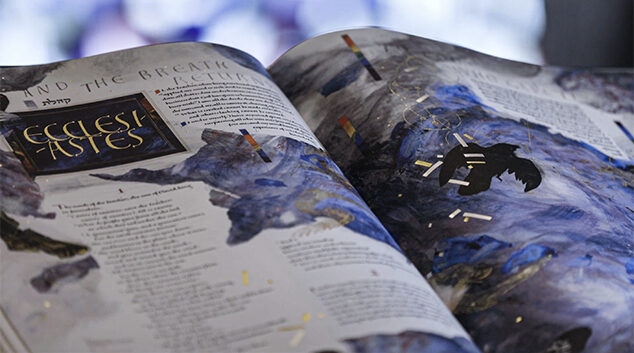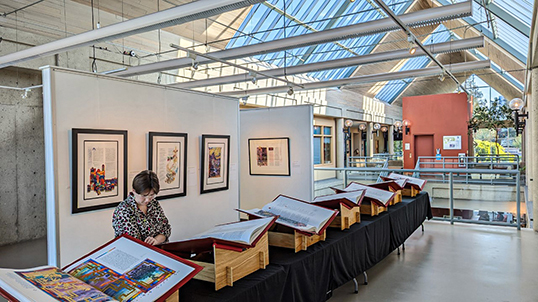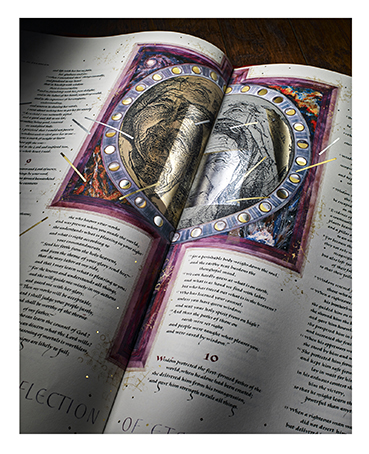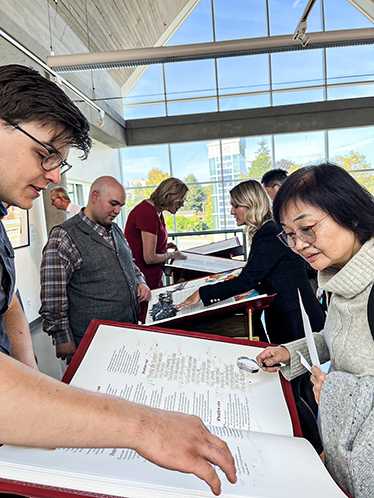The Saint John’s Bible Heritage Edition at Regent College: Ancient Art For the Modern Era
Vancouver, British Columbia – There is much more to the art of hand-scribed manuscript creation than simply recording. The imprint of a human hand on sacred texts breathes life into words that many of us have heard hundreds of times throughout our lives. Where a quill marks a page and rises again ignites a sense of human-to-human connection, familiarity, and artistry that simply cannot be replicated with other, mechanical means of printing.
Since 529 AD, the Benedictine Order has carried the torch of Christian manuscript creation and preservation, a tradition that began when Benedict of Nursa wrote the Rule of Benedict, the core of Benedictine religious practices.
However, when Johannes Gutenberg invented the printing press in 1440, this rich tradition fell into a quiet slumber for centuries, lying dormant as a press took over what once was a solely human effort. Western monastic documents were no longer touched by a human hand and goose quill; they filtered through a press.
Though this dormancy continued for centuries, calligraphers carried on the artistic tradition in ways other than manuscript creation, until yet another invention once again threatened the art
of hand-written manuscripts and calligraphy in the 1970s and 80s: computer fonts were invented.
Amid the growing mechanization of the lettering arts, there grew a subsect of artists who yearned for a return to a kind of artistry grounded in human touch. Worldwide, scribes worried: would computers be the death of calligraphy? To determine the future of the craft, they assembled at Saint John’s University and Abbey in Collegeville, Minnesota, for the first annual International Calligraphy Conference.

Little did they know, the appearance of one particular scribe at this Conference would lay the pathway to reinvigorate the craft in a way that hadn’t been done in 500 years. The keynote speaker of the Conference, Donald Jackson, former Senior Scribe to the late Queen Elizabeth II’s Crown Office at the House of Lords, had been secretly wishing to fulfill a childhood dream of his, to hand-scribe and illuminate the entire Bible.
Here, at Saint John’s University, Jackson realized he may have found the institution to help him achieve this dream.
This was the impetus for what became The Saint John’s Bible, the first handwritten illuminated Bible commissioned by a Benedictine monastery in over 500 years.
In the 500 years since work of this scale was last attempted, much had changed. Global powers shifted. Countries rose and fell. Technology grew exponentially. Humankind had touched the moon and, for the first time, witnessed a view of the Earth from beyond its atmosphere. Globalization led to an unprecedented level of interreligious dialogue and conflict. Yet, fine, sacred art that incorporated this new abundance of knowledge and culture was scarce.
These were the conditions that inspired The Saint John’s Bible. In addition to reviving a tradition that had been nearly absent from the Christian world since the 15th century, the creators wished to ignite the spiritual imagination of people of all faith journeys all over the world, by illustrating scripture as it might appear in the world as we see it today.
Under Jackson’s fastidious creative direction, The Saint John’s Bible was brought slowly and diligently into existence by a team of gifted scribes, artists, and assistants. Letter by letter, line by line, year by year, across an astonishing 1,100 gorgeous handwritten pages. All told, it took Jackson’s talented team 15 years to complete this colossal work.

As the team of calligraphers, scholars, and theologians worked every day to perfect the manuscript, a concern grew: How would this work of sacred art and scripture be shared with the world?
After all, its creators always envisioned wider distribution. They wished for The Saint John’s Bible to be experienced, enjoyed, and shared all over the world by people from all faith backgrounds. To satisfy this desire, Jackson’s team needed to replicate the singular artistry of the original manuscript without losing its extraordinary divine spirit. So, they gave the world The Saint John’s Bible Heritage Edition.
The Heritage Edition is a fine-arts reproduction that’s been thoughtfully designed to faithfully capture the same artistic spirit and grand scale of the original manuscript. Printed and embossed on cotton, hand-bound in Italian calfskin leather, and limited to only 299 seven-volume sets, the Heritage Edition is a rare masterwork of its own right, possessed of the same breathtaking power to ignite the spiritual imagination as the original manuscript. Beautifully handcrafted with materials that will stand the test of time, the Heritage Edition is a powerful, enduring symbol of generosity, goodwill, love of community, and unwavering faith.
The Heritage Edition at Regent
Today, Heritage Editions of The Saint John’s Bible live all over the world. To date, over 170 Heritage Editions have been acquired by families, churches, schools, libraries, universities, healthcare centers, and retreat centers of many faith traditions.
One such edition happens to live at Regent College. Gifted in 2021, the College has used the Heritage Edition to ignite the spiritual imagination on campus in many ways.

For example, in October 2022, Regent hosted a gallery show titled The Word Come to Life, featuring many illuminations from The Saint John’s Bible. All seven volumes of Regent’s Heritage Edition were used in the show. Regent also incorporates the Heritage Edition into events such as chapel services and Graduation Tea.
Regent College’s Allison Library hosts ‘Open Pages’ events each semester, where several volumes are displayed in the College’s Atrium. Open Pages allows students, faculty, and community members to informally experience The Saint John’s Bible. By reflecting together on the illuminations, seekers learn more about themselves, each other, and their own conceptualizations of the Word of God.
“Regent has long been dedicated to an integration of theology and the arts, including our unique Christianity and the Arts concentration that allows students to submit original artwork in place of a traditional thesis,” said Colton Whelpton, Library Services Manager at Regent. “The focus on the importance of the arts as an integral expression of human creativity is one of the reasons we were so thrilled to house such a remarkable gift like The Saint John’s Bible Heritage Edition.”
As Regent has found, the Heritage Edition is also a phenomenal tool for fostering relationships with groups outside of the College. Frequently, high school students, local church community groups, and more have visited Regent for one-hour guided tours of all seven volumes of the Heritage Edition.

Of course, the College also uses the Heritage Edition for worship, events, and graduate-level courses for Biblical Studies and Art and Theology.
When the Heritage Edition isn’t being used in these ways, it lives in Regent College’s Allison Library. Each morning, Whelpton turns the page.
“Visitors to Regent College will gather around the display case to take in whichever illumination is featured at the time, and when I am able, I come out of my office to lift the glass and show them a few additional pages,” said Whelpton. “While many of our regular students walk by, focused on their next paper, I am always delighted to see the same students notice when a new page is displayed and stop to take a brief moment and read the passage.”
While the tradition of monastic manuscript creation and keeping continues to evolve over time, The Saint John’s Bible Heritage Edition lives as both a remarkable reminder of where we came from and artistic and imaginative fuel for where we will go next.
The Saint John’s Bible: Ignite the Spiritual Imagination
To learn more about The Saint John’s Bible and the Heritage Edition, visit www.saintjohnsbible.org.
To inquire about how you can gift a Heritage Edition of The Saint John’s Bible to an institution close to your heart, click here.
For more stories similar to this one, visit the blog, subscribe to The Saint John’s Bible monthly e-newsletter, and follow @saintjohnsbible on Instagram, Twitter, and Facebook.


